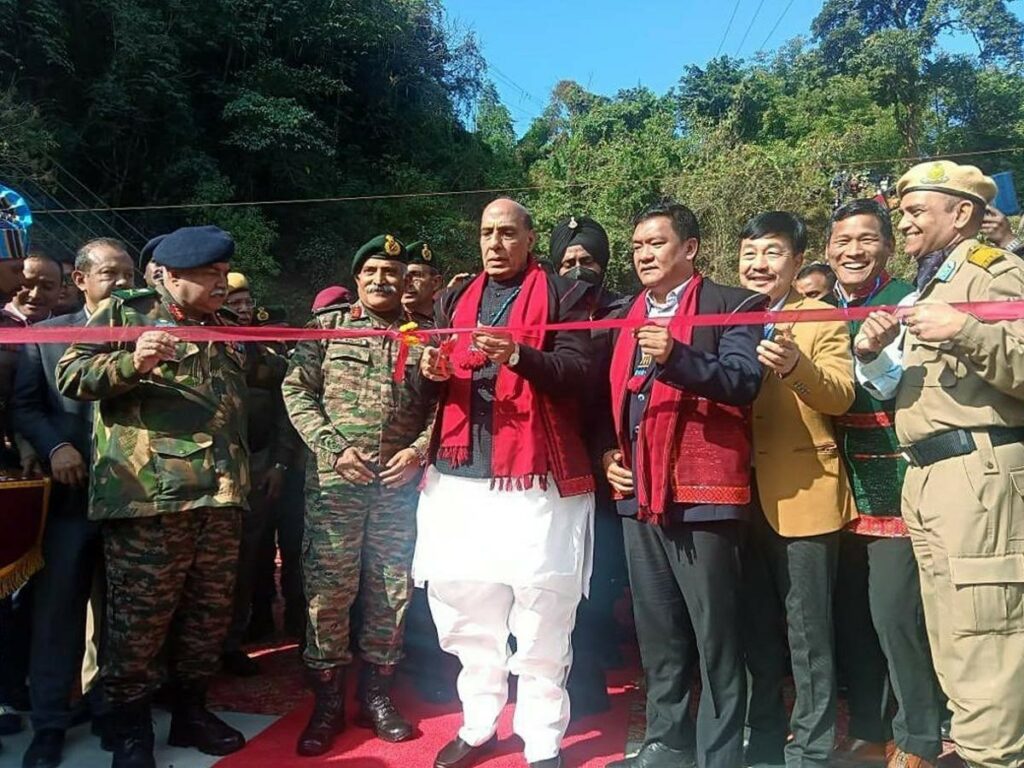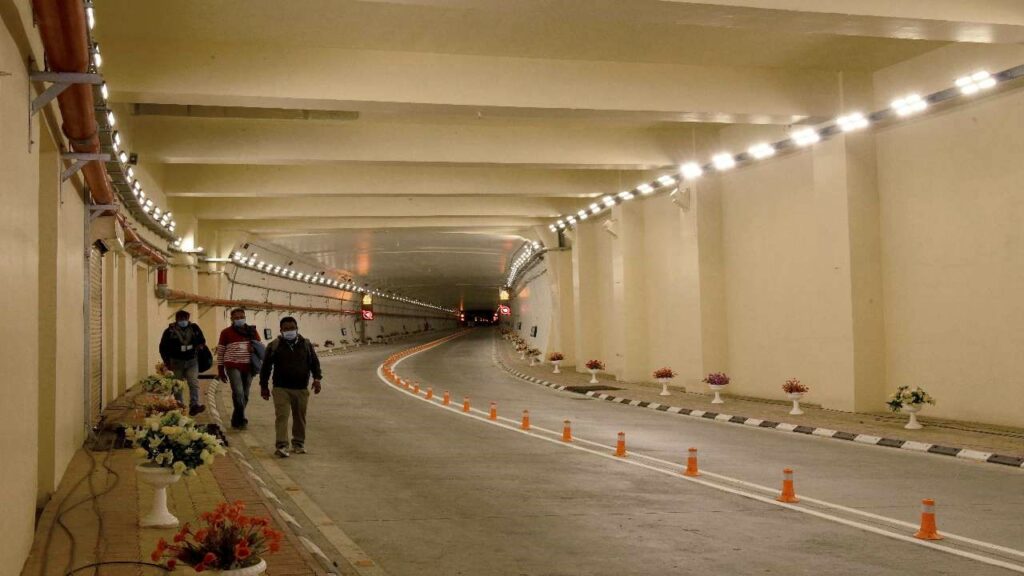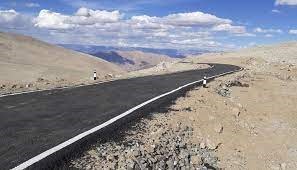The Border Roads Organisation [BRO] has been executing a large number of projects across border areas and in difficult terrains within India. In light of the inauguration of Siyom bridge, Raksha Mantri Shri Rajnath Singh in January dedicated 28 infrastructure projects of the Border Roads Organisation (BRO), worth Rs 724 crore. The projects comprise 22 bridges, including Siyom bridge, three roads and three other projects in seven border states and union territories & the northern and northeastern regions. Eight of these projects are in Ladakh; five are in Arunachal Pradesh; four are in Jammu & Kashmir; three each in Sikkim, Punjab, & Uttarakhand; and two are in Rajasthan. In addition, three telemedicine nodes – two in Ladakh & one in Mizoram were also inaugurated.

In his address, the Raksha Mantri described the projects as a testament to the concerted efforts of the government and the BRO towards the development of border areas in order to enhance the operational preparedness of the Armed Forces and ensure the socio-economic development of the far-flung regions. The Raksha Mantri further highlighted the crucial role played by the BRO in bolstering the country’s security through infrastructure development in border areas.
With the infrastructure growing in the country, it has stood up and delivered where there is difficulty in construction. It is a road construction organisation that provides support and is an integral part of the Indian Armed Forces under the MoD (since 2015). The organisation is involved in the development of road infrastructure in border regions of the country, which not only enhances the operational capability of the Indian Armed Forces but also provides last mile connectivity by integrating border villages. The organisation’s operations began in May 1960 with just two projects: Project Tusker (renamed Project Vartak) in the east and Project Beacon in the west. It has evolved since then.
The role of BRO in infrastructure development
BRO develops and maintains road networks in India’s border areas and friendly neighbouring countries. This includes infrastructure operations in 19 states and three union territories (including the Andaman and Nicobar Islands) and neighbouring countries such as Afghanistan, Bhutan, Myanmar, Tajikistan, and Sri Lanka. The organisation has not only linked the border areas of the north and north-east with the rest of the country, but has also developed the road infrastructure in Bihar, Maharashtra, Karnataka, Rajasthan, and Andhra Pradesh.
They have been executing projects in some of the most difficult terrains of the country. Despite dealing with challenges such as extreme temperatures and difficult geographic conditions, These projects typically include developing roads, bridges, and airfields in hostile environments shunned by private enterprises, whether due to security concerns related to hostilities, or because of environmental challenges. In the last two years, they have completed 205 infrastructure projects at a cost of 5,126 crore.
It is also working for the development of insurgency-prone, remote, and inaccessible areas. The roads constructed by the organisation pass through high altitude passes like Zozila ( Alt 11578 ft ), Changla (Alt 17350 ft ), Khardungla ( Alt 18380 ft ) and Thanglangla ( Alt 17582 ft) in the state of J&K. Roads cross through Sela Pass ( Alt 13765 ft ) in Arunachal Pradesh and Nathula Pass ( Alt 14140 ft ) in Sikkim. BRO has also bridged river gaps of the hilly region of North & North East with equipment bridges ( Bailey, Bailey suspension, Hamilton and Inglis Bridges).
BRO is adopting technology advancements
The Border Roads Organisation (BRO) enhances its capability through optimum use of technology and strives to strengthen the infrastructure of the border areas at a faster pace. The construction around border areas requires the adoption of modernized technology and equipment to tackle rough terrain and harsh weather conditions.
The organisation has already adopted a modern technology, the Cementaceous Sub Base (CTSB), a first-of-its-kind in Asia, for the construction of the sensitive high-altitude Daulat Beg Oldi road bordering China in eastern Ladakh. This is a patented technology through which road surfaces are constructed in an extremely short span of time. The surface is more durable than the one obtained through the conventional method. Under the CTSB technology, a dry admixture is mixed with sand and crushed stones by means of a machine known as a pulveriser. First the crushed stones and sand are spread on the road. The admixture is placed in front of the pulveriser. The pulveriser rolls over the admixture, mixing all three components and evenly spreading them across the road surface.For a while, the surface is watered.The exercise is repeated after a few days to form the second coating. Then the bitumen is laid over the surface, as in the conventional method.
The organisation has also adopted the use of special construction equipment, a special variant of L&T wheel loaders. The equipment units were used for working in harsh terrain, such as high altitudes and extreme weather conditions,. These construction equipment were fitted with ‘Cold Starting Kits’,for construction work in sub-zero temperatures of up to minus 20 degrees.
They are now keen on adopting space technology for real-time monitoring of its strategic assets, including roads, bridges, and tunnels, given the increasing presence of Chinese troops in the northern and northeastern sectors. They want to use the technology to monitor projects on the China border. The organisation has used an aerial electromagnetic system to prepare DPR for tunnels. Likewise, they want to use real-time technology. They soon plan to submit a problem statement to iDEX to find apt solutions at the earliest.
Significant projects completed by BRO




- Atal Tunnel in Rohtang – a 9.02 Km-long tunnel and is recognised as the world’s longest highway tunnel, at an altitude above 10,000 feet. It is a single-tube, double-lane, horseshoe-type tunnel with a design speed of 80 km per hour.
- Highest motorable road at Umling La Pass in Ladakh: The Border Roads Organisation (BRO) has created a world record by constructing and black-topping the world’s highest motorable road at Umling La Pass in Ladakh at an altitude of 19,024 feet. The road connects important towns in the Chumar sector of Eastern Ladakh. It offers an alternate direct route connecting Chisumle and Dhemchuk from Leh.
- Chamba Tunnel in Uttarakhand – 440 m long tunnel constructed under the town on the Rishikesh-Dharasu road in Uttarakhand. It is a horseshoe-shaped tunnel. The completion of this tunnel has helped increase connectivity to far-off places in the Garhwal region of Uttarakhand.
- 578 m-long Theng Tunnel on the Chungthang-Mangan highway in North Sikkim—the longest bi-directional tunnel in Sikkim. It has improved connectivity to the border regions. Similarly, the 120 m-long cut-and-cover Sonapur Tunnel in Meghalaya has improved movement by enabling all-weather connectivity between Meghalaya and the Barak Valley District in Assam.
- The 100-metre long steel arch Siyom Bridge along-Yingkiong Road- a 100-meter ‘Class-70’ steel arch superstructure- will facilitate faster induction of troops, heavy equipment like howitzers, and mechanised vehicles to forward areas of the Upper Siang district, Tuting and Yinkiong regions along the LAC (Line of Actual Control) with China.
Upcoming projects
A total of 28 projects at the cost of Rs 724.3 crore are being undertaken by BRO across the country in strategic locations, including eight in Ladakh, two in Rajasthan, three each in Uttarakhand and Punjab, and four in the Union Territory of Jammu and Kashmir. The bridges being constructed at an altitude of 14000 feet in Ladakh are very critically located on D-S-DBO Road. Once completed, these bridges are expected to facilitate faster induction of the troops, movement of heavy equipment and mechanised vehicles to the forward areas in Ladakh up to Karakoram Ranges, and also the Galwan valley, where at some friction points the standoff between Indian and Chinese troops continues.
Government recognises BRO’s hard work
Recognising the organisation’s pace of road construction in border areas, the government has increased the capital budget of the Border Roads Organisation (BRO) by 43 percent to Rs 5,000 crore in the 2023–24 budget as against Rs 3,500 crore in 2022–23. BRO has seen its capital budget rise sharply over the last few years. According to the Ministry of Defence (MoD), the capital budget of the BRO has been doubled in two years since FY 2021–22.
Conclusion
The road construction in India is undergoing a paradigm shift. Robust demand, higher investments, support in liquidity, and significant policy support are changing the face of the sector. The current standoff with China is an eyeopener for Indian strategic policymakers.The recent initiative of opening up to private sector participation in BRO contracts is a welcome step in speeding up project completion and capacity of nation building.
References- timesofindia.com, outlookindia.com, mdoner.gov.in/border-roads, ANI, financialexpress.com, Marvels.bro.gov.in, pib.gov.in, bro.gov.in

